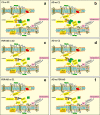Changes in cholesterol metabolism-related gene expression in peripheral blood mononuclear cells from Alzheimer patients
- PMID: 22414021
- PMCID: PMC3323438
- DOI: 10.1186/1476-511X-11-39
Changes in cholesterol metabolism-related gene expression in peripheral blood mononuclear cells from Alzheimer patients
Abstract
Background: Cholesterol homeostasis dysfunction has been reported to have role in the pathogenesis of Alzheimer disease (AD). Therefore, changes in cholesterol metabolism in blood components may help to develop new potential AD biomarkers. In this study changes in cholesterol metabolism-related gene expression genes were evaluated in peripheral blood mononuclear cells (PBMCs) from AD subjects, their first degree relatives (FDR) and two groups of age matched controls (C1 > 80 years, C2 < 60 years). The expression of three genes related to APP processing was also determined.
Results: Results showed significantly different behavior (P = 0.000) in the expression of all analyzed genes among the 4 groups. An inverse correlation emerged between the age of controls and the propensity of their PBMCs to express selected genes. Moreover, when gene expression was evaluated in PBMCs from AD patients and compared with that of PBMCs from healthy subjects of the same age, LDL-R and APP mRNAs were most abundant in AD as compared C1 whereas SREBP-2 and particularly nCEH were present at much lower mRNA levels in AD-PBMCs. This study describes for the first time a differential expression profile of cholesterol and APP related genes in PBMCs from AD patients and their FDR.
Conclusions: We suggest that the expressions of cholesterol homeostasis and APP processing related genes in PBMC could be proposed as possible biomarkers to evaluate AD risk. In addition, gene expression in PBMC could be also used for diagnosis and development of therapeutic strategies as well as for personalized prediction in clinical outcome of AD.
Figures




References
Publication types
MeSH terms
Substances
LinkOut - more resources
Full Text Sources
Medical
Miscellaneous

